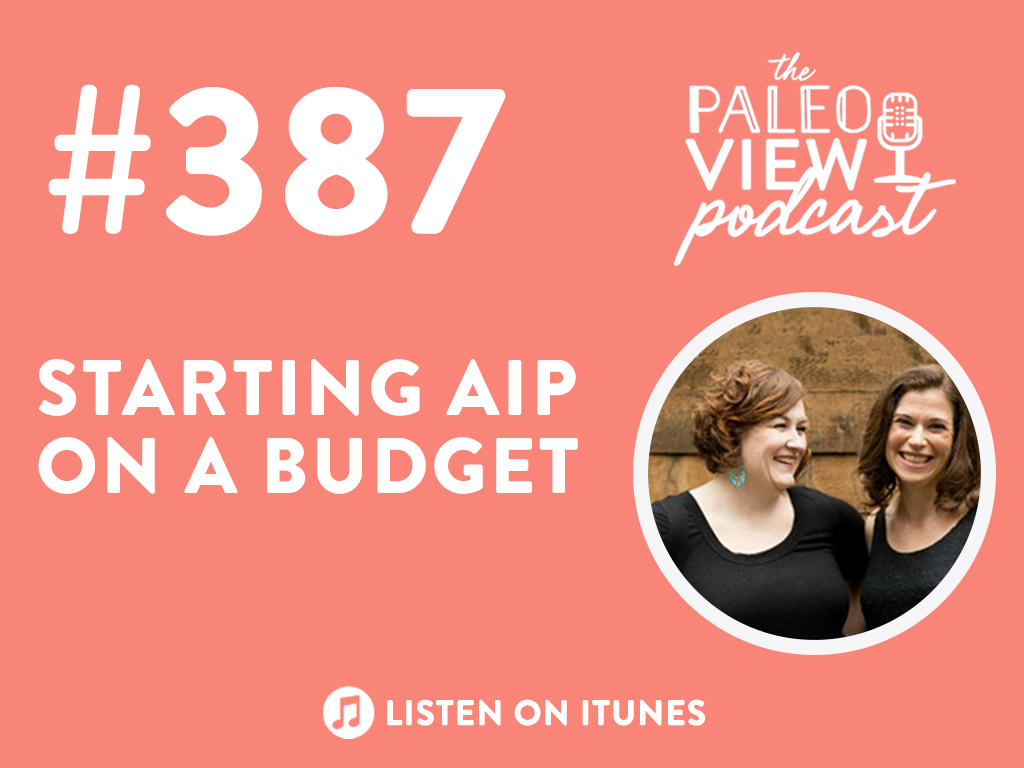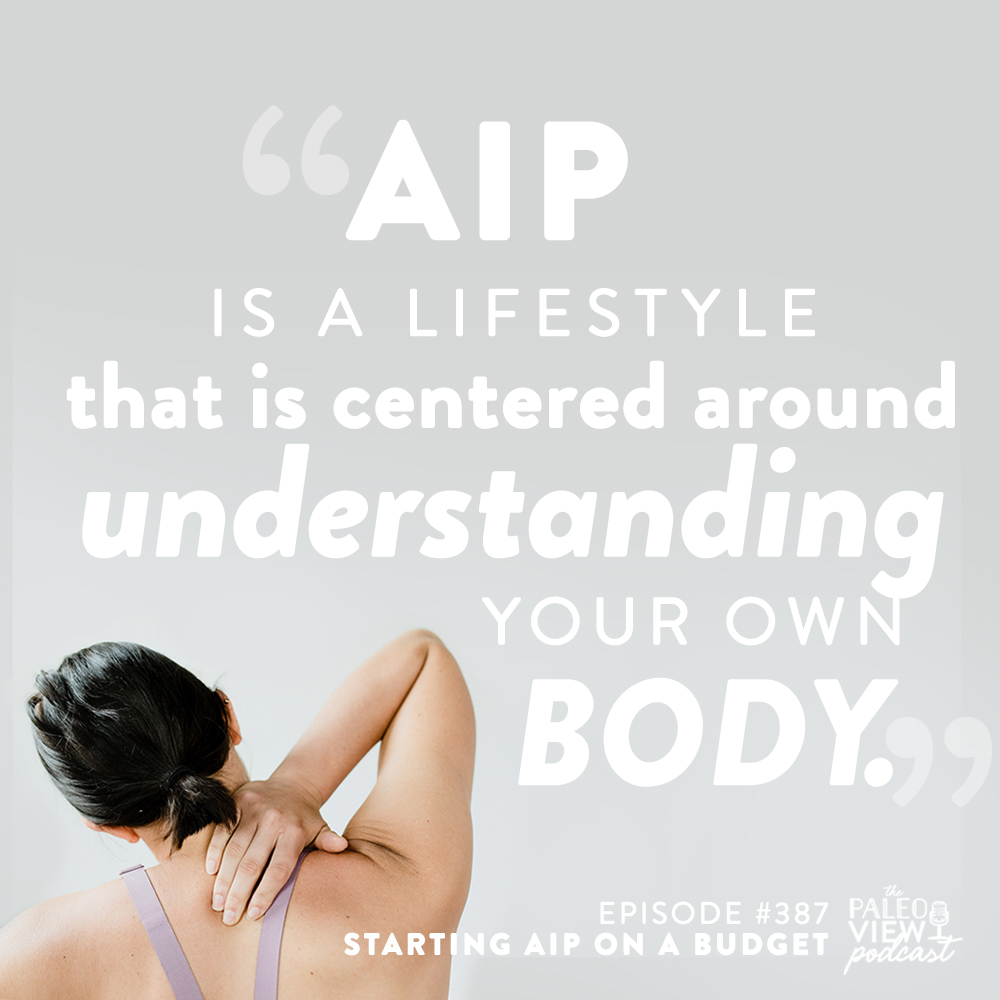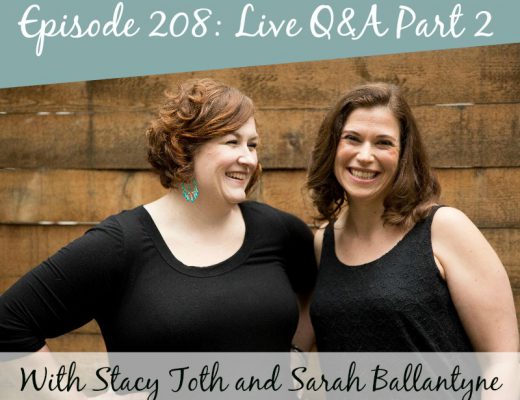
On this week’s show, Stacy and Sarah answer a listener’s question on how to approach the autoimmune protocol while on a budget. The hosts tackle this question by going back to square one, where do you focus your energy when an AIP approach is completely new? And what do you prioritize? All of this and more in episode 387!
If you enjoy the show, please review it on iTunes!
The Paleo View (TPV), Episode 387: Starting AIP on a Budget
Welcome back to The Paleo View! (0:40)
Stacy is so excited; life is great.
Matt and Stacy went through some hard times in life for a while, and she is in awe to be going through a really great season in life right now.
Sarah’s family made two resolutions together as a family.
The first is to do an outdoor activity together as a family every weekend.
The second is that they would do meditations together as a family, and they are using the app Headspace for this.
They are doing them before bed, and for five minutes.
Stacy is excited to help Barbara this week.
A reader question came in that inspired this week’s episode and is a unique challenge for both Stacy and Sarah to answer.
Sarah loves the idea of getting back to basics and talking about what it is like to start AIP for someone who is new.
Listener Question
Barabara is 75 years old and is on social security.
She wants to do the autoimmune protocol, and her question is:
How can I do the AIP diet? Where do I begin?
Sarah thinks it is awesome to take a step back and to talk about where it is best to put that initial effort at first.
One of the things that most resonated with Stacy when starting her AIP journey, was to think about what she is adding in versus what she is taking out.
The thought process is that we’re adding in nutrient density.
As a reminder, nutrient density is that for every calorie you are eating you are maximizing the amount of nutrients you can get for that food.
That the food is high in fiber, or other minerals and vitamins, different kinds of things that are adding value to your health.
We are adding in nutrient density to nourish and heal our bodies so that we can feel our best.
The Starting Point
As someone who is just starting and where to begin, we are just trying to nourish the body to feel it’s best and taking away the things that cause the inflammation and the auto-immune systems.
A diet is not healthy or unhealthy based on what you avoid.
So Sarah likes to talk about any diet from the standpoint of what we eat, versus what we avoid.
Sarah thinks that as we go through the steps on where to start with AIP, it is very helpful to adopt a positive focus on what we do get to eat.
It is a subtle shift in mindset, but it can make all the difference.
We need to not just think about the autoimmune protocol, but the mindset around food in general.
This sets us up for a journey, as opposed to a dietary intervention that is going to be on for a while and then off.
Working to find a maintenance diet that is going to work for you as an individual is key.
AIP is designed as a thorough template to get to that point.
Lists & Labels
Sarah feels that the next step is food lists. (12:12)
It is necessary information to know what to eat and what to avoid.
There are free lists on Sarah’s site, and in this eBook there are very thorough lists as well.
Sarah created that eBook to be very comprehensive to expedite the application of AIP.
From there, Sarah thinks developing the skillset of reading food labels is important.
Using the food lists to inform you, and then reading labels to build awareness.
Go through the pantry, and put anything to the side that is Paleo but not AIP.
Even those who aren’t necessarily new to AIP will find it very helpful to revisit ingredient lists and check the prep details with restaurants.
Stacy likes to think of AIP as an elimination diet to see what works and what doesn’t work for your body.
The goal is for it be for a set amount of time to help your body to heal.
It doesn’t have to be a forever thing.
Meal Planning & Prep
Sarah likes to put her AIP lecture series students through an exercise to help with this process.
The students look at the meals they already eat that are very close to AIP, and look for the little swaps they can make to adapt the recipe to be fully AIP.
Look at what you are already cooking and love and look at where you can make a small change.
You can build from there once you have those favorites.
Sarah also noted that now there are so many amazing AIP resources available on the internet.
There are AIP cookbooks you can buy, but there are also so many AIP recipe bloggers that have content available for free.
When selecting your go-to recipes, think of what will realistically work for your lifestyle and schedule.
Shop from your pantry and freezer to check what you already have when building out your meal plan.
When you shop, adjust bit by bit as opposed to stocking up on all the things at once.
Find a blogger who likes the kind of things that you like and they will offer recipes that follow suit.
Stacy noted that it is an easy step to double a recipe so that you can freeze and save for later.
These back up meals will go a long way to add convenience into your elimination diet process.
The Learning Curve
If you are someone who usually eats out, you will need to get use to eating from home for a bit where you can maintain control of your ingredients.
This will help you avoid the risk of cross-contamination.
Eating from home is also simply cheaper.
As you get further into your modifications and your journey, you will be able to decide if you want to reinvest your dining out budget into higher quality foods.
Getting use to shopping, cooking and planning ahead is part of the learning curve of AIP.
Stacy noted that we also need to be able to ask for help when we need it.
There are going to be a lot of dietary adjustments to simply be aware of and patient through.
Lifestyle Elements
While there are a lot of dietary changes to be made, people sometimes get 100% focused on the diet aspects alone.
However, lifestyle is super important for immune regulation as well.
The two most important things from a lifestyle perspective to commit to in the early phase is setting a grownup bedtime and sticking to it.
The ideal bedtime is eight to eight and a half hours before you need to get up in the morning.
This needs to account for the time it takes you to fall asleep and any restless periods during the night as well.
If this is a big change from where you are currently at with your sleep, you are going to want to add on twenty minutes every few days until you hit that goal.
Starting that commitment to getting enough sleep in the early phase is very important.
Getting enough sleep will also help with hunger and hormone regulation.
The second piece that Sarah recommends is committing to a twenty to thirty-minute walk outside every day.
If you are a really active person, Sarah reminds anyone who is looking at AIP that avoiding strenuous activity is part of the protocol.
Strenuous or prolonged activity is inflammatory.
If you are someone who is sedentary and works at a desk for long periods throughout the day, make sure you are getting a movement break every 20 minutes.
Stacy shared why she recommends water aerobics as a great movement option for someone following AIP.
This idea is about starting to increase movement, not necessarily about hitting a cardio goal.
Ease into the diet without ignoring lifestyle.
Sarah thinks that one of the best things people can do in order to set themselves up for success with AIP and beyond is to educate yourself on the protocol why’s.
Doing so will allow you to understand where the gives and takes are.
Knowing the details will help you troubleshoot when you need to, stay motivated to keep going, when and where to refine, etc.
A common misstep that Sarah sees is when people combine protocols.
Don’t make it harder on yourself than it needs to be.
If you are doing AIP, stick with that and see how it goes.
This is why Sarah developed such thorough resources for AIP, specifically The Paleo Approach and the Autoimmune Lecture series are great tools.
Sarah is only teaching once lecture series in the year ahead, which will start March 9.
The code ‘PaleoView’ is still active and will get you $100 off your tuition.
Budget Limitations
There are places where it is harder to get fresh produce.
You will need to be proactive in these areas and look for produce delivery or CSAs.
If it is a budget component that is impacting your access to produce, Sarah recommends not worrying about organic.
It is still important to focus on nutrient-dense foods even if they aren’t in the ideal form.
Sarah has what she calls stretch vegetables that are foods that help to stretch a meal.
These items are cabbage, winter squash, and sweet potatoes.
You get a lot for the price per pound on these items.
The most expensive AIP ingredients are the purchases used for AIP treats.
These are nice for feeling like you are not giving something up, but these treats aren’t necessary for healing.
It will not take long for your palette to adjust to fruit being a treat.
Eating AIP on a budget is absolutely possible.
Most CSAs and farmer’s markets now take food stamps, so explore this option as well.
Other than that you are doing the best you can.
Frozen fruits and vegetables tend to be better than fresh because they are picked ripe and frozen right away.
If you are going to do canned, just make sure you read the labels.
Sarah suggested other ways to cut grocery costs.
Stacy suggested bananas, plantains, and carrots as other stretch foods that they always have around.
Onions are another food that Matt and Stacy try to add to everything.
Reintroduction
AIP is a collection of tools that are about expediting healing because you are flooding the body with nutrients and eliminating the most likely dietary triggers of your autoimmune symptoms.
This toolbox also gives you the tools to understand your own body.
Reintroduction will teach you what foods you can eat for your body, and which foods you can’t.
When approaching reintroduction, focus on the foods that are going to add the most nutritional value to your diet.
However, there is a case to be made in this situation to introduce budget-friendly foods.
Reintroduction is a phase of AIP.
First, you work on nutrient density and you eliminate possibly problematic foods and work on lifestyle.
Then you try reintroductions and learn about your body.
You then find something in between that works for you, your body, and your budget.
Sarah thinks of this stage as the maintenance phase.
Think of your AIP as a journey, don’t hit your head against the wall before troubleshooting or refining.
If you are getting to three or four months and not seeing any improvements, that’s when finding a great doctor to work with or an AIP certified coach will help you troubleshoot.
Closing Thoughts
The AIP is a lifestyle that is centered around understanding your own body.
There is a huge piece of this about developing lifelong habits.
Understand that there is no cure to autoimmune disease.
Following the AIP can put some conditions into remission.
However, there are a lot of variables that contribute to reaching this step.
Autoimmune disease is a moving target.
We have to be vigilant and aware; ready to dive in when needed.
It is a wonderful collection of tools that allow you to navigate health challenges in the future more successfully.
Stacy recommends finding a community.
Sarah even has an The Paleo Mom Community Facebook group where you can connect with others for support and encouragement.
Having a support system will go a long way to help make this sustainable long-term.
Stacy and Sarah wish Barbara well and thank her for the great question she submitted!
The hosts will be back next week!
Please be sure to share with others who you think would be interested in this week’s episode, and leave a review in whatever platform you are using to tune in.
Thanks for listening!





